

Digital Citizenship Lessons en Français. As educators and librarians, incorporating digital citizenship into our daily instruction can be a tall order.
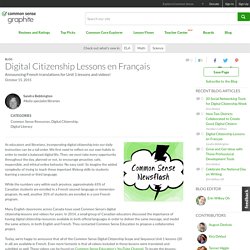
We first need to reflect on our own habits in order to model a balanced digital life. Then, we must take every opportunity throughout the day, planned or not, to encourage proactive, safe, responsible, and ethical online behavior. No easy task! So imagine the added complexity of trying to teach these important lifelong skills to students learning a second or third language. While the numbers vary within each province, approximately 65% of Canadian students are enrolled in a French second-language or immersion program. Digital Citizenship Explained by Common Craft. Most people are good citizens in the offline world.
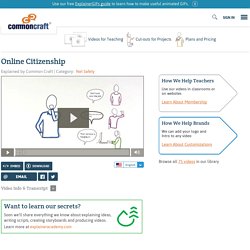
They are kind to others, they obey laws and want their community to be a better place. But these days many of us are also citizens of the online world. We participate in discussions, share photos, and get help using websites. While this makes communication faster and easier, it can also cause problems. Stewart is a good guy. But when Stewart goes online, he seems to become a different person. He often writes provocative comments on blogs and video websites without contributing anything valuable. Recently a friend recognized his online name on a few comments and gave him a call. Stewart was speechless - he never meant to hurt anybody. "Manners Matter" Digital Citizenship Tips [Infographic] GDCF.
Enjoy this useful infographic produced by Knowthenet called Manners Matter.
!["Manners Matter" Digital Citizenship Tips [Infographic] GDCF](http://cdn.pearltrees.com/s/pic/th/citizenship-infographic-115960350)
And they do, especially when it comes to teaching students proper digital citizenship skills. Resources such as this are a terrific way to share what’s important about technology with today’s digital learners! Knowthenet is a digital citizenship organization that helps individuals, families and businesses get the most out of the Internet. They align with national and international organizations to help make being online safe and secure. Creating Awareness for Bullying Prevention, Digital Citizenship and Cybersecurity.
Digital Citizenship. Sample Digital Literacy and Citizenship Scope And Sequence From The Mulgrave School. Digital Literacy and Citizenship The digital literacy scope and sequence we built for Mulgrave School Above is the link to our new Digital Literacy & Citizenship (DLC) scope and sequence.
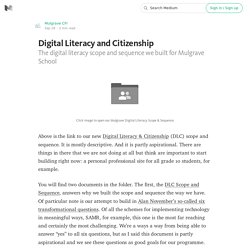
It is mostly descriptive. And it is partly aspirational. There are things in there that we are not doing at all but think are important to start building right now: a personal professional site for all grade 10 students, for example. You will find two documents in the folder. The document also gives a high level view of what we expect students to be able to do in each of several age groupings — K-G1, G2-G3, G4-G5, G6-G8, G9-G10 and G11-G12. The 9 essential elements of digital citizenship. Every digital citizen should have these skills To hear author Mike Ribble tell it, kids are entering school with some exposure to technology—meaning schools won’t be making a first impression.
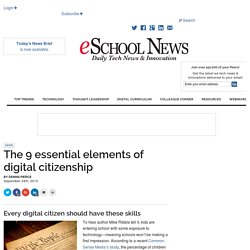
According to a recent Common Sense Media’s study, the percentage of children ages eight and under who’ve used a mobile device nearly doubled from 2011 to 2013, from 38 percent to 72 percent. And about two in five children under the age of two have used a mobile device. Digital Citizenship Week Resources for Schools. Digital Citizenship: An Opportunity for Everyone. Contributed by Jason Ohler In many parts of the world, one of the most universally available international experiences is traveling the world wide web.
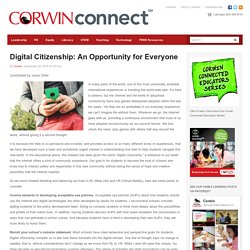
It’s hard to believe, but the Internet and the world of ubiquitous connectivity have only gained widespread adoption within the last ten years. Yet they are so embedded in our everyday experience we can’t imagine life without them. Wherever we go, the Internet goes with us, providing a continuous environment that most of us have adopted unconsciously as our second homes. We text, check the news, play games with others half way around the world, without giving it a second thought. It is because the Web is so pervasive and invisible, and provides access to so many different kinds of experiences, that we have developed such a keen and sometimes urgent interest in understanding how best to help students navigate this new world.
Involve students in developing acceptable use policies. Revisit your school’s mission statement. Jason Ohler. School Resources - NetSafe Utah. Global Digital Citizenship—in 15 Minutes! (Solution Fluency) By focusing on Global Digital Citizenship every day for 15 minutes, you can instil in your students a strong basis for Internet-savvy skills for the 21st Century.

This is the first in a series of templates for lesson plans on the 21st Century Fluencies. First up: Solution Fluency. You heard that right, we said 15 minutes—take this lesson in parts; one part each day. You can spread this out over a couple weeks time or however you wish. The premise for our 15 minutes comes in the form of flipped videos or material that students will examine at home, or at the very least to be highlighted and watched in class for 15 minutes or less.
6 Great Videos on Internet Safety and Digital Citizenship. About ETR Community EdTechReview (ETR) is a community of and for everyone involved in education technology to connect and collaborate both online and offline to discover, learn, utilize and share about the best ways technology can improve learning, teaching, and leading in the 21st century.

EdTechReview spreads awareness on education technology and its role in 21st century education through best research and practices of using technology in education, and by facilitating events, training, professional development, and consultation in its adoption and implementation. Digital Citizenship Resources for the Primary Classroom.
I know it may sound a bit odd, but I love Monday mornings.

Why? I get to start every Monday morning during the first semester talking Digital Citizenship with our 94 Kindergartners. If you are a Kindergarten teacher and you're reading this, thanks for being AWESOME! I admire you more than you will ever know. I have a hard enough time keeping these students engaged for 25 minutes, I can't imagine what it's like for 8 hours! As we get settled into our new school years, I thought I would share some of my favorite resources that I use with our primary students here at Aurora Elementary School. Embracing the 9 Themes of Digital Citizenship. As our society races toward a realization of the Internet of Things, there is an increasing emphasis in the world of K-12 education to get technology into the hands of staff and students.
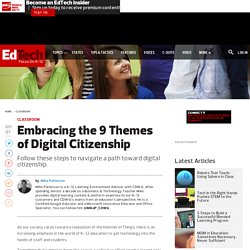
Something that’s missing from this race is a collective effort to educate not only our students but also our staff on the importance of understanding what it means to be a responsible digital citizen. We have access to more information through various mediums and more exposure to the world around us than ever before. With this access and exposure comes a responsibility that people of all ages are lacking a true understanding of — namely, the lasting digital footprint that we create every day. Part of my role as a learning environment adviser for CDWG is to have conversations with district stakeholders and ask questions like, “Why do you want those devices?” Digital Citizenship for Elementary Kids: 6 Awesome Activities. On one of our many walks to school, my 11-year-old son asked, “What are you blogging about these days, Dad?” I replied, “Digital Citizenship and elementary kids. So, what is it that kids do on computers most?”
“Games and videos.” I can attest to that. My son likes to watch videos of game walkthroughs where people take videos of themselves playing through a game to the end, all while commenting on what’s going on; much like watching a movie. Now the adult in me wanted to say, “You should use it for learning and collaborating and organizing.” Almost knowing what I was thinking he said, “There are games that are fun and that teach me biology and physics and stuff.” Digital Citizenship for Elementary Kids: 6 Awesome Activities. Does Your School Need Digital Citizenship Lessons? The 7 Question Test.
Posted on August 11, 2015 by Diana Graber Earlier this summer, Disneyland announced that it was issuing a ban on the selfie stick. They decided that the “magic wand of narcissism,” as the selfie stick has been called, had no place at the happiest place on earth. Selfie sticks have also been banned at other public venues, from New York’s Metropolitan Museum of Art to the Coliseum in Rome. Meanwhile, Russia’s Ministry of Internal Affairs just launched a public health campaign, called the “Safety Selfie,” to reduce deaths and injuries caused by people taking dangerous selfie photos. Is Cyberbullying On the Rise?
Whenever I see these headlines I want to cringe. The fact is, it’s sad we need headlines to remind us to continue to be kind to others, to continue to discuss with our children as well as our friends and colleagues about the importance of being an upstander when you see someone being shamed online and most importantly — it’s a reminder that this digital cruelty is not going away anytime soon. The fact is – there is a live person on the other-side of the screen. Whether it is a smartphone, a laptop, a tablet or a PC – you have the potential to destroy someone’s life with your keypad. Yes, keystrokes (with a click of a mouse) have become a deadly weapon at all ages – and in many cases – it’s completely legal. "We shouldn't assume people know what digital citizenship is."
“We shouldn’t assume people know what digital citizenship is.” by David Ryan Polgar and Marialice B.F.X. Curran, DigcitSummit.com Digital Citizenship is huge. Or so it seems by the countless articles we read on the topic each week. As plugged-in educators who are putting together the first annual Digital Citizenship Summit, we are swimming in a sea of amazing advice concerning cyberbullying, empathy online, public shaming, tech balance, digital tattoos, and more. Teach Digital Citizenship: 20+ Tips & Resources. A List of Digital Citizenship Resources For Fouth Graders. As the beginning of a new school year approaches, we need to remember to include lessons on the importance of Digital Citizenship in our classrooms. As I begin my second year of being 1:1, I know this is important to incorporate.
Listed below are sources that can be used to teach Digital Citizenship in the classroom.Common Sense Media Classroom Curriculum - Lessons promoting and encouraging digital literacy and citizenship. Digital Citizen Toolkits by Common Sense MediaDigital Compass - Where are you headed? Provided free from Common Sense Media. There is a video to show first. Tech Ed Resources for your Class–Digital Citizenship Curriculum. I get a lot of questions from readers about what tech ed resources I use in my classroom so I’m going to take a few days this summer to review them with you. Some are edited and/or written by members of the Ask a Tech Teacher crew. Digital Citizenship is Much More Than Internet Safety. Digital Citizenship is Much More Than Internet Safety. Common Sense Digital Citizenship: Certified District. Districts across the country have many responsibilities, from ensuring students’ safety to making sure that they are prepared to thrive and learn in the 21st century.
Digital Citizenship in the Digital Classroom. Digital Citizenship Project/Resources From The Association of Library Consultants and Coordinators of Ont #edtechbc. How You Can Become a Champion of Digital Citizenship in Your Classroom. To Teach or Not to Teach? Digital Citizenship in the Elementary Classroom « Technology Leadership. With the never-ending list of things on teachers plates, the last thing teachers want to hear about is another topic they are responsible for teaching. The Common Core Standards, routines, school-rules, social skills, and now we are suppose to teach students how to behave online too? Digital Citizenship and Online Safety Resources. Online Safety & Digital Citizenship from K to 6. As a tech teacher, I consider the most vital part of my job is to teach students how to use technology safely and responsibly. Last year, in my new role as an Instructional Technology Teacher, I have discussed online safety and digital citizenship with most of my classes and assigned activities related to it sporadically throughout the year.
Digital Citizenship Resources. Digital citizenship in the real world: Learning on and off-line civics. Whenever I taught civics, I repeatedly told my classes that I would measure my success as a teacher on how many of them were voting in elections in five years. Of course, I had no way to measure this, but it was one of my most concrete goals of teaching a civics course. This was my definition of active citizenship. It was based on an earlier definition of citizenship, before I had fully integrated the lessons from Thomas Friedman’s The World Is Flat into my classroom. The 9 Elements of Digital Citizenship Infographic. Digital access, commerce, communication, literacy and etiquette… What do these words have in common?
Well, for starters, they are all components of digital citizenship. 4 Global Digital Citizenship Myths—Debunked! #edtechbc. 10 Strategies to Help Kids Use Smartphones Wisely and Prevent Cyberbullying Common Sense Education Launches Free Gaming Platform to Teach Digital Citizenship. Excellent Tool to Teach Students about Digital Citizenship and Digital Literacy. Teacher's Guide to Digital Citizenship. Teaching Digital Citizenship: Digital Law. 6 Rules of Digital Citizenship for Kids - Blog (Retiring) Online Safety: A Teacher’s Guide to Dealing with Cyberbullying, Sexting, and Student Privacy. MF Quickstart Guide. Digital Citizenship: Preparing Students for Life. Top 10 Steps To Respond To Cyberbullying 9 resources for teaching digital citizenship. Online Safety: A Teacher’s Guide to Dealing with Cyberbullying, Sexting, and Student Privacy #edtechbc.
Five Ways for High School Seniors to Establish a Digital Footprint. Digital Citizenship Lesson Flow: Helping Kids Communicate with Teachers. Digital Literacy and Citizenship Curriculum by Common Sense Media Available for Free. Preventing Cyberbullying: Top Ten Tips for Educators - Cyberbullying Research Center. 3 ways to weave digital citizenship into your curriculum. Digital Compass: Interactive Adventure For Gr 6-9 Stus To Learn Digital Citizenship.
Education's Digital Citizenship Policy Development Guide. Digital Citizenship. 10 Things to Teach About Global Digital Citizenship. Online Digital Citizenship Education Training Program From NetSmartz and Club Penguin #edtechbc. Know the ISTE Standards for Administrators: Digital citizenship. 7 Ways To Prevent Cyberbullying #edtechbc. How To Deal With Cyberbullying. Assortment Of Classroom Posters On EdTech and Digital Citizenship. New Digital Citizenship Starter Kit for Remind. Developing Digital Citizenship through Mobile Communication.
Digital Bytes: Online resources for teaching digital citizenship through student-directed activities #edtechbc. 4 fresh ideas for teaching digital citizenship sooner. More Advice On Your Digital Footprint. 19 Topics to Teach in Digital Citizenship and How. Digital Citizenship Resources. Digital Citizenship Resources Teachers Should Know About. Clean Up Your Digital Footprint. Online resources that promote students' digital citizenship #edtechbc. 9 resources for teaching digital citizenship. [VIDEO] Your Digital Footprint: School Leader Edition. Digital Literacy and Citizenship Resources From The South West Grid For Learning (UK) 9 Amazing Resources to Promote Internet Safety and Digital Citizenship. 13 Resources To Help You Teach Digital Citizenship. 3 ways to weave digital citizenship into your curriculum. Global Digital Citizen Foundation. Digital Citizenship: It takes an iVillage To Raise an Online Child.
How to Instill Digital Citizenship in Students. 9 resources for teaching digital citizenship. International Collaboration-Tips. 9 resources for teaching digital citizenship. 24 Project Based Learning (PBL) Ideas from Global Digital Citizenship Foundation.